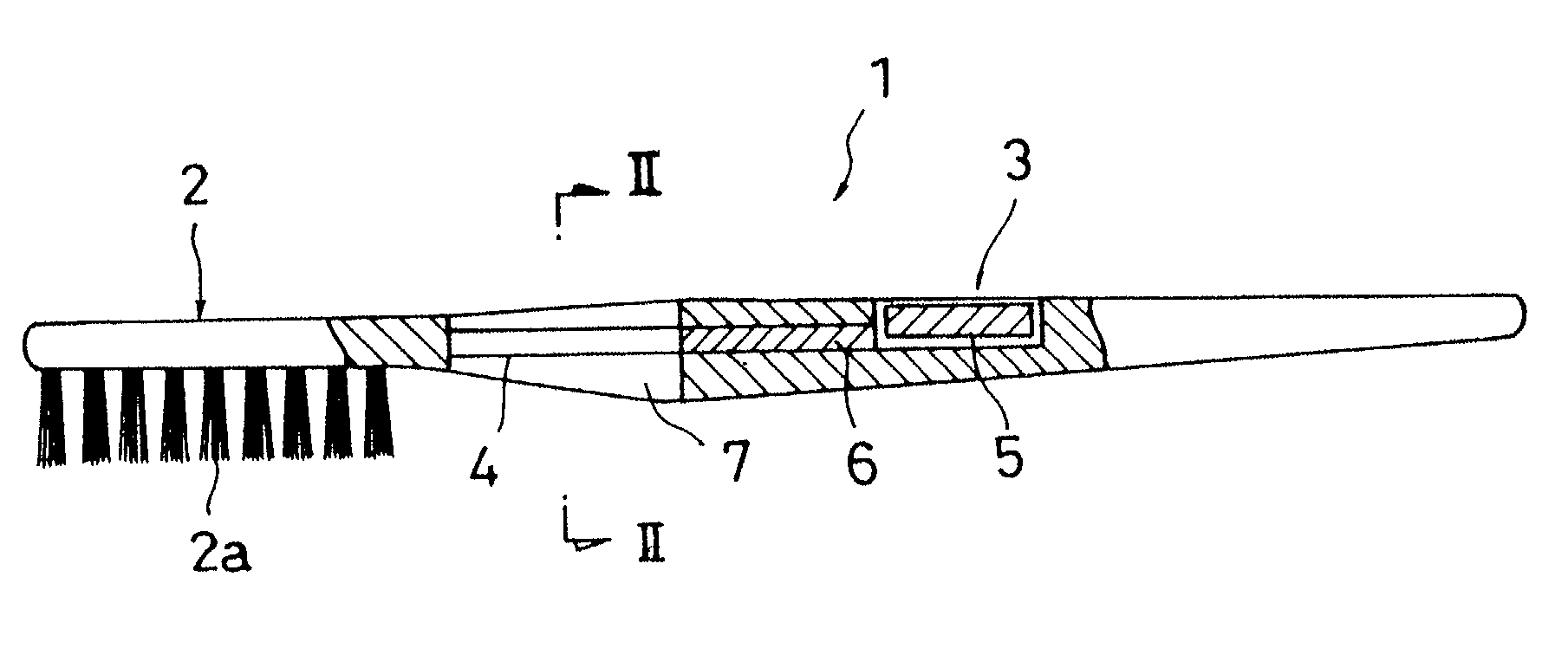[0009] In view of the above problems, it is an object of the invention to provide an electronic toothbrush which, by using a
photocatalytic reaction of the n-type semiconductor, not only decreases the activity of etiologic bacteria of dental caries but also improves
decomposition of generated
lactic acid, thereby preventing dental caries more effectively, and to provide an electronic brush which can wash each part of a body more effectively than the case where washing is conducted simply by using
soap water, by decomposing organic waste such as
dirt generated at each part of the body.
[0011] According to the present configuration, owing to the photocatalytic action of the n-type semiconductor, in the case where the toothbrush is inserted into an
oral cavity, in addition that OH radicals generated by
decomposition of
moisture such as
saliva increase the pH within the oral cavity to neutralize the same, thereby decreasing the activity of etiologic bacteria of dental caries, the OH radicals reliably and rapidly decompose lactic acid generated by lactic
fermentation of foods by bacteria, so that it is possible to prevent dental caries from occurring. In other words, in contrast to the case where only the photocatalytic action of n-type semiconductor effected by external light is employed (e.g.
fluorescent lamp in a washroom), by superposing the
electric potential of the battery, it is possible to achieve an
energy level required for decomposing lactic acid and water, so that the photocatalytic efficiency of the n-type semiconductor can be improved synergistically. As a consequence, it is possible to improve the efficiency of generation of OH radical while reliably improving the pH by
tooth brushing operation. Additionally, in the case of practically performing
tooth brushing operation in a washroom and the like, even under the condition that
light irradiation is weak because illumination of lighting equipment such as fluorescent lump in the washroom is low, since the battery which makes the
electric potential of the n-type semiconductor more than or equal to a predetermined value is provided, it is possible to stably achieve a desired effect. As a result, according to the present invention, it is possible to provide an electronic toothbrush that can prevent intraoral diseases such as dental caries more effectively.
[0013] According to the present configuration, TiO.sub.2 is effective for improving
decomposition of lactic acid or the pH because it exhibits particularly large photocatalytic efficiency among n-type semiconductors, and use of TiO.sub.2 is advantageous because the electric potential required for causing a photocatalytic action is maintained more than or equal to the predetermined value, as well as the current flowing into a
human body via the hand is kept especially weak to arise no
adverse effect on the
human body. In other words, if the output of the battery is less than or equal to 0.5V, decomposition of lactic acid is insufficient, whereas if the output of the battery is more than or equal to 3.0 V, decomposition of lactic acid is promoted, however, the current flowing into a human body is increased to cause discomfort, and thus such ranges are not preferable.
[0017] The present configuration is advantageous because it is possible to readily secure the battery output of more than 0.5 V and less than 3.0 V while realizing durability and low cost. As the
primary battery, an
alkaline battery, a sliver
oxide battery, an air /
zinc battery and the like can be used, while as the secondary battery, a
nickel /
hydrogen battery, a
lithium battery and the like can be used.
[0019] The present configuration is advantageous because such a type of TiO.sub.2 has particularly large photocatalytic efficiency among other types of TiO.sub.2. In this context, an
anatase-type
crystal can be easily obtained, for example, by the method of heating pure Ti to 1200 to 1500.degree. C. for several minutes in an oxidizing
atmosphere.
[0021] According to the present configuration, owing to the photocatalytic action of the n-type semiconductor, in the case of washing each part of a body using
soap water and the like, OH radicals generated by decomposition of
moisture reliably and rapidly decompose organic waste such as
dirt on the
skin surface, so that higher washing effect is achieved compared to the case where only the
soap water is used. In other words, in contrast to the case where the photocatalytic action of the n-type semiconductor is caused by only the external light (e.g.
fluorescent lamp in a bathroom or washroom), by superposing the electric potential of the battery, it is possible to achieve an
energy level required for decomposing organic waste on the
skin surface and water, so that photocatalytic efficiency of the n-type semiconductor can be improved synergistically. As a consequence, it is possible to improve the efficiency of generation of OH radical by scrubbing operation of
skin surface. Additionally, in the case of practically performing washing operation in a bathroom and the like, even under the condition that
light irradiation is weak because illumination of lighting equipment is low, and even if the lighting equipment is an incandescent lamp rather than a
fluorescent lamp, since the battery which makes the electric potential of the n-type semiconductor more than or equal to a predetermined value is provided, it is possible to stably achieve a desired effect. As a consequence, according to the present invention, it is possible to provide an electronic brush capable of washing each part of a body more effectively compared to the case where washing is performed with only soap water.
 Login to View More
Login to View More  Login to View More
Login to View More 


